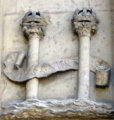
Casa consistorial de Sevilla
Encyclopedia
The Casa consistorial de Sevilla is a Plateresque
-style building in Seville
, Spain
, cirrently home of the city's government .
The building has a large façade divide into five modules, decorated by Plateresque reliefs. these include grotesque motifs of Italian Florentine architecture inspiration, heraldry symbols, allegories of Justice and Good Government and depictions of mythological of historical characters such as Hercules
, Julius Caesar
and emperor Charles V
.
 In 1526, the marriage in Seville of emperor Charles V
In 1526, the marriage in Seville of emperor Charles V
(Charles I of Spain) nd his cousin Isabella of Portugal
occasioned the construction of a building for the city government that would represent the power and importance of the city at that time.
Until then, the council or cabildo of Seville had its seat in some houses of the Corral de los Olmos, a location now occupied by the Plaza de la Virgen de los Reyes, behind the Cathedral of Seville. The new building was to be built at the Plaza de San Francisco, central to the city and its commercial district, behind the eponymous convent and in front of the Audiencia (judicial court).
The construction was designed and directed by architect Diego de Riaño
from 1527 until his death in 1534. He was succeeded by Juan Sánchez (who built the arcade which now connects the building with the Plaza Nueva) and, later on, by Hernán Ruiz the Younger.
Plateresque
Plateresque, meaning "in the manner of a silversmith" , was an artistic movement, especially architectural, traditionally held to be exclusive to Spain and its territories, which appeared between the late Gothic and early Renaissance in the late 15th century, and spread over the next two centuries...
-style building in Seville
Seville
Seville is the artistic, historic, cultural, and financial capital of southern Spain. It is the capital of the autonomous community of Andalusia and of the province of Seville. It is situated on the plain of the River Guadalquivir, with an average elevation of above sea level...
, Spain
Spain
Spain , officially the Kingdom of Spain languages]] under the European Charter for Regional or Minority Languages. In each of these, Spain's official name is as follows:;;;;;;), is a country and member state of the European Union located in southwestern Europe on the Iberian Peninsula...
, cirrently home of the city's government .
The building has a large façade divide into five modules, decorated by Plateresque reliefs. these include grotesque motifs of Italian Florentine architecture inspiration, heraldry symbols, allegories of Justice and Good Government and depictions of mythological of historical characters such as Hercules
Hercules
Hercules is the Roman name for Greek demigod Heracles, son of Zeus , and the mortal Alcmene...
, Julius Caesar
Julius Caesar
Gaius Julius Caesar was a Roman general and statesman and a distinguished writer of Latin prose. He played a critical role in the gradual transformation of the Roman Republic into the Roman Empire....
and emperor Charles V
Charles V, Holy Roman Emperor
Charles V was ruler of the Holy Roman Empire from 1519 and, as Charles I, of the Spanish Empire from 1516 until his voluntary retirement and abdication in favor of his younger brother Ferdinand I and his son Philip II in 1556.As...
.
History

Charles V, Holy Roman Emperor
Charles V was ruler of the Holy Roman Empire from 1519 and, as Charles I, of the Spanish Empire from 1516 until his voluntary retirement and abdication in favor of his younger brother Ferdinand I and his son Philip II in 1556.As...
(Charles I of Spain) nd his cousin Isabella of Portugal
Isabella of Portugal
Isabella of Portugal was a Portuguese Princess and Holy Roman Empress, Duchess of Burgundy, and a Queen Regent/Consort of Spain. She was the daughter of Manuel I of Portugal and Maria of Aragon. By her marriage to Charles V, Holy Roman Emperor, Isabella was also Holy Roman Empress and Queen...
occasioned the construction of a building for the city government that would represent the power and importance of the city at that time.
Until then, the council or cabildo of Seville had its seat in some houses of the Corral de los Olmos, a location now occupied by the Plaza de la Virgen de los Reyes, behind the Cathedral of Seville. The new building was to be built at the Plaza de San Francisco, central to the city and its commercial district, behind the eponymous convent and in front of the Audiencia (judicial court).
The construction was designed and directed by architect Diego de Riaño
Diego de Riaño
Diego de Riaño was a Spanish architect of the Renaissance. He was one of the most outstanding architects of the Plateresque style....
from 1527 until his death in 1534. He was succeeded by Juan Sánchez (who built the arcade which now connects the building with the Plaza Nueva) and, later on, by Hernán Ruiz the Younger.

